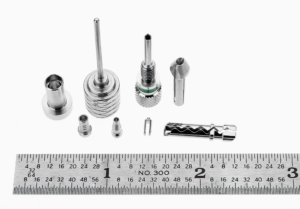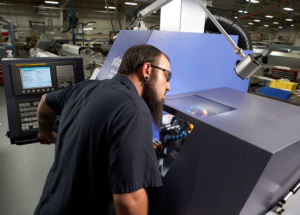Swiss Turning
A “Swiss-type” lathe is unique for its “sliding headstock” style of machining.
 The bar stock is rigidly clamped in the main spindle of the machine and moved back and forth as necessary through a rotating bushing. This rotating guide bushing produces support for the machining at a very short distance away from the cutting tool. Only the section of the material that is currently being machined protrudes from the bushing, maximizing rigidity, and in turn minimizing deflection nearly completely. . If additional support is required, The second spindle, or so called Sub Spindle can be used to further reduce deflection and increase rigidity to the section of the material being machined.
The bar stock is rigidly clamped in the main spindle of the machine and moved back and forth as necessary through a rotating bushing. This rotating guide bushing produces support for the machining at a very short distance away from the cutting tool. Only the section of the material that is currently being machined protrudes from the bushing, maximizing rigidity, and in turn minimizing deflection nearly completely. . If additional support is required, The second spindle, or so called Sub Spindle can be used to further reduce deflection and increase rigidity to the section of the material being machined.
Close tolerances must be adhered to on the outside diameter of the material used to reap the benefits of full support from the guide bushing . This type of tolerance is usually obtained from Centerless Grinding of the material before the Swiss Operation. The tighter the tolerance of the material, the greater the accuracy in machining.
 The availability of rotating tools gives Swiss-type machines the ability to produce other types of features on a part such as a cross holes or milled flats. These machining capabilities allow a complex part to be produced in a single machine.
The availability of rotating tools gives Swiss-type machines the ability to produce other types of features on a part such as a cross holes or milled flats. These machining capabilities allow a complex part to be produced in a single machine.
Although some conventional CNC lathes can produce rotating tool operations, the unique design of Swiss Lathe machines allow this type of work to be produced with much greater accuracy.
